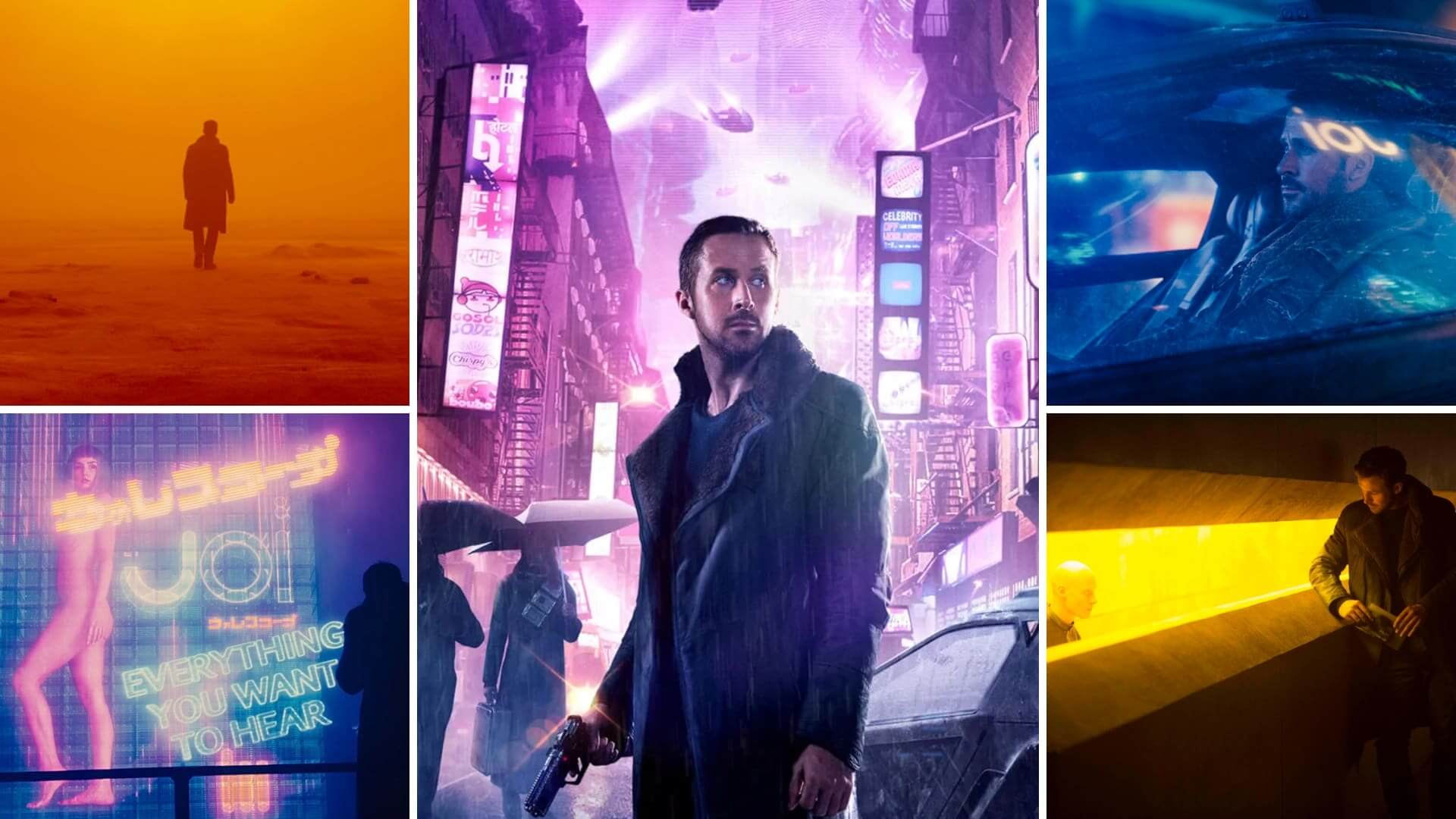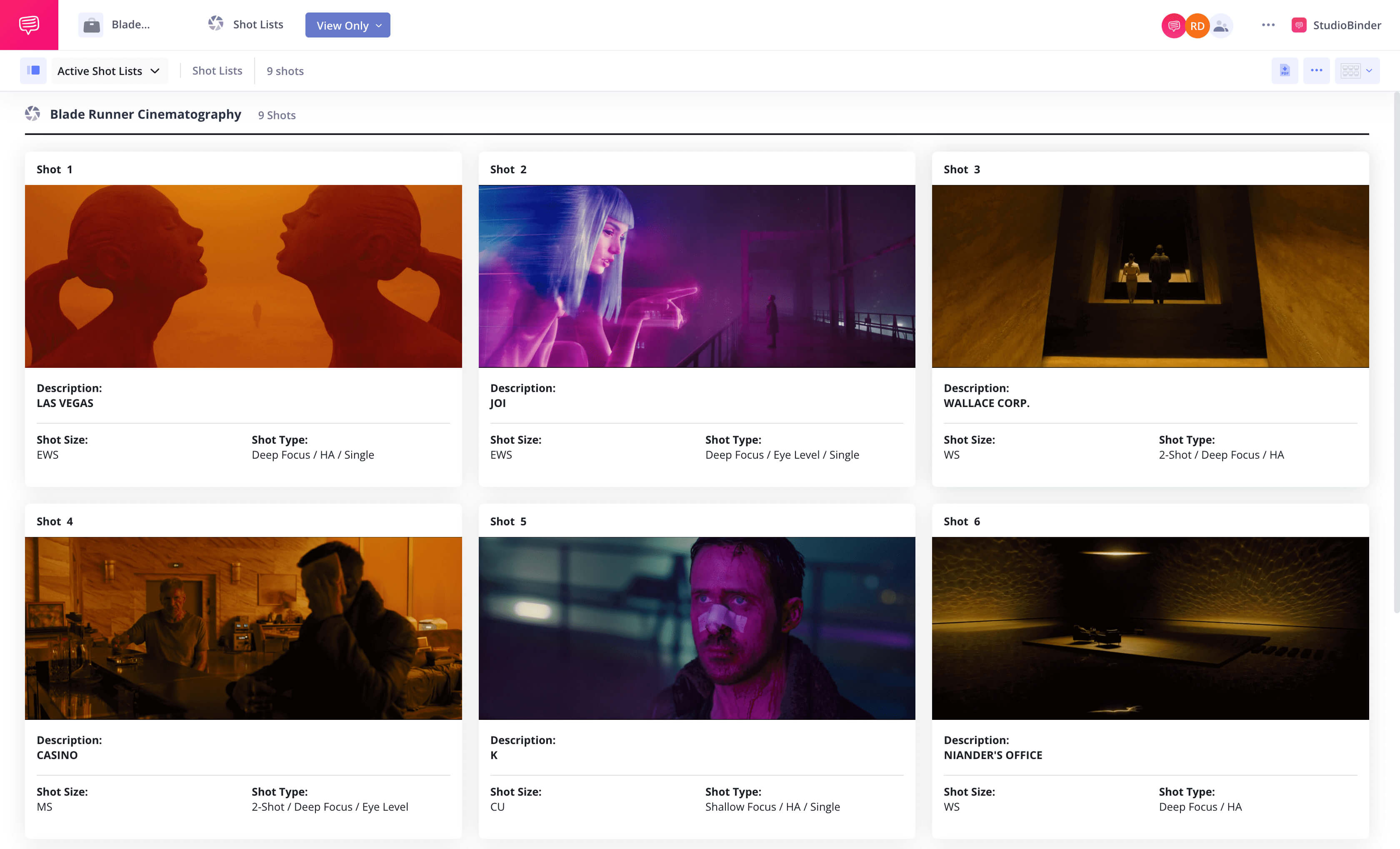If you remember only one thing from Denis Villeneuve’s Blade Runner 2049, it’s probably the visuals. The sandstorm-struck Las Vegas, the neon advertisements, the hypnotic interior of Wallace’s office, the smog-blanketed Los Angeles. Blade Runner 2049 is filled with stunning images that leave impressions that last long after the film is over. It should be no surprise, then, that the film was shot by one of the most acclaimed cinematographers of all time, Roger Deakins. Together with Villeneuve and a massive team of top-notch professionals, Deakins created a striking visual style that leaves you breathless. Let’s take a look at the elements that make the Blade Runner 2049 cinematography great, and see what we can learn for our own projects.
Blade Runner 2049 Cinematography
Use the set to your advantage
Half of the cinematography of Blade Runner 2049 is mise en scene — what’s in your shot and how it’s organized — and the production design of this film is impeccable. The buildings are sharp and geometric, the futuristic technology is sleek but textured, the landscape is barren and foreboding.

Walking into the abyss • Blade Runner 2049 Cinematography
Predictably, cinematographer Roger Deakins and director Denis Villeneuve put a lot of thought into the set design in the film. According to Deakins, they pulled visual inspiration from locations as disparate as Beijing, Sydney, Southern Spain, and Saudi Arabia.
The result is a rich and detailed background to each scene, which Deakins highlights and uses to his advantage in his camera framing. For example, he uses the harsh geometry of the buildings to create frames within frames.
Notice in these shots how the angles created by the architecture of the set frame our characters:

Frames within frames • Cinematography Blade Runner 2049
Of course, the attention to detail in set design allows for stunning wide shots, allowing the viewer to take in the atmosphere of the science fiction world. The harsh architecture looks even more imposing and daunting when our protagonist is dwarfed by it:

The cinematography of Blade Runner 2049
The interplay between cinematography and set design is key to making the Blade Runner 2049 aesthetic work. Without a deeply thought-out mise-en-scene and a camera that uses it to enhance its frame, the film would feel far less rooted in its own built reality.
Here's a primer on Roger Deakins' cinematography and style.
Roger Deakins’ style summarized • Subscribe on YouTube
Roger Deakins Blade Runner 2049 Cinematography
Create dynamism with practical lighting
Remember how we said half of cinematography is mise en scene? Well, the other half is lighting, and Roger Deakins pulls no punches in this field either. The most notable aspect of the lighting in the Blade Runner 2049 cinematography is just how much it moves.
There are hardly any scenes with totally stationary lighting. If you’ve ever set up lighting before, you know just how hard (and expensive) this is to pull off practically, not to mention the headaches it can create in the editing room.
But the shifting lighting throughout Blade Runner 2049 is crucial to its visual palette. This is a dystopian techno-future where the primary source of light is no longer the sun: like everything in this world, light is manmade.
Because of this, the source of light in most scenes is practical lighting, or, in other words, originating from elements within the story. Hear Deakins himself discuss how and why he uses practical lighting:
Deakins on Practical lighting • Subscribe on YouTube
Practical lighting could be a fake sun reflecting off of pools of water. For more, here are tips on how to create this Blade Runner water lighting effect.

Deckard doesn’t appreciate the beauty of lighting
Or it could be an insane Elvis hologram concert extravaganza.
Hundreds of light rigs at use • Blade Runner 2049 cinematography analysis
The list could go on and on, but a common factor between all of these diegetic light sources is that they all are in constant movement. This shifting lighting creates dynamic and alluring footage without being distracting — because we know what the source of the moving light is, it enhances the reality of the scene rather than takes away from it.
Again, this is far from easy. To achieve this effect, you need a massive and skilled crew on hand to create, operate and move light fixtures, or you need a programmable LED light board, or you may need both.
ROGER DEAKINS ON THE JOI/K AD SCENE
“We shot the ‘Pink Joi’ element first. When we shot the scene with Ryan, I felt it important that we play the element at a true scale so that the lighting could be interactive between the advert and K. There’s rain and fog in the scene, so we filled the stage with mist and had this 40-by-30-foot LED screen playing back the image that we had shot during preproduction. The pink-and-blue advert was basically lighting the whole shot — the atmosphere and Ryan. The light changes as the advert changes.”
Our protagonist stares at an ad (which happens to be the love of his life)
Blade Runner 2049 Cinematography
Fog, mist, and more fog
An inescapable element of the Blade Runner 2049 cinematography is the heavy use of fog. In just about every exterior scene (and a decent amount of interior scenes) characters and landscapes are cloaked in fog or similar atmospheric effects. It’s a well-known fact amongst cinematographers that fog/smoke always looks great on camera, and so often the visual effect can be overused or unmotivated.
The use of fog in Blade Runner 2049, however, is deliberate and serves multiple purposes in each scene.
First, the fog that blankets the future-cities of Blade Runner 2049 adds to one of the main themes and setting characteristics of the movie: that the human race has destroyed Earth’s habitat.
This ever-present smog reinforces this idea throughout the film.

The first shot of LA • Blade Runner 2049 aesthetic
The fog also gives a hazy, dream-like feel to the film, a feel which the first Blade Runner established so masterfully. Cityscapes seemingly go on forever. Characters, objects, entire buildings fade in and out of view, like tears in rain.
Additionally, heavy smoke allows a skilled director of photography like Roger Deakins to direct a viewer’s attention to specific elements of a frame. Thick fog can act as a blank background without being boring, since it is always fluctuating and interacting with objects in the scene. Here are just a few of the most stark uses of fog that inform the Blade Runner 2049 aesthetic:

Blade Runner 2049 stills • Fog and atmospherics
Notice what you can and can’t make out in each of these images. Every object that isn’t obscured by fog is important. Anything less important? It’s behind the curtain of smoke.
Fog also has a great practical use, as well: it diffuses light. Luminescence coming from diegetic city lights and futuristic tech can be harsh. So putting it behind a natural diffuser like smoke is a great way to achieve soft light without sacrificing diegetic realism.
Spreading the light through fog also helps create Villeneuve’s color palette for each scene. If your purple light is being refracted by smoke, it will be everywhere in your shot, not just on the subject. In this shot, Joi’s purple glow spreads throughout the frame like watercolor on a wet canvas:

Fog, purple light, Ana de Armas • Blade Runner 2049 color palette
By paying meticulous attention to set design, lighting, and atmospherics, Roger Deakins and his team created an unforgettable dystopian visual landscape.
Take a look at this mood board, which we imported into StudioBinder's shot listing software, to see how individual shots come together to create this immersive world. Click the image to download the collection to inspire your next project.
Sure, not all of us have access to an astronomical budget and a massive crew of industry veterans, but the basic building blocks at work in Blade Runner 2049’s cinematography can be utilized by anyone.
Related Posts
UP NEXT
Roger Deakins Cinematography Tips
Blade Runner 2049 is just one example of Roger Deakins’ stellar cinematography. To learn more about what he’s shot and how he’s shot it, check out our summary of everything we can learn from Deakins’ cinematography techniques and interviews.
Up Next: Roger Deakins Tips →
Share your vision with elegant shot lists and storyboards.
Create robust and customizable shot lists. Upload images to make storyboards and slideshows.

